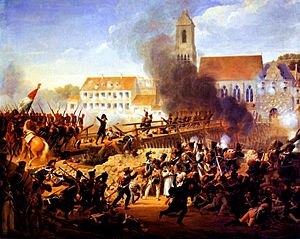Battle of Landshut (1809) facts for kids
Quick facts for kids Battle of Landshut |
|||||||
|---|---|---|---|---|---|---|---|
| Part of the War of the Fifth Coalition | |||||||
 General Mouton leads the grenadier companies of the 17th line regiment across the bridge at Landshut |
|||||||
|
|||||||
| Belligerents | |||||||
| Commanders and leaders | |||||||
| Strength | |||||||
| 60,000-77,000 | 42,000 | ||||||
| Casualties and losses | |||||||
| less than 1,000 | 8,000 | ||||||
The Battle of Landshut was a major fight that happened on April 21, 1809. It was part of the War of the Fifth Coalition. This battle took place in Landshut, a town in Bavaria.
The battle was fought between the French army, along with their allies from Württemberg and Bavaria, and the Austrian army. The French side was led by the famous Napoleon. His army had about 77,000 soldiers. The Austrian army, led by General Johann von Hiller, had about 36,000 soldiers. Even though the Austrians were outnumbered, they fought bravely. However, once Napoleon himself arrived, the battle quickly turned into a clear victory for the French.
Before the Battle: Setting the Scene
There were actually two smaller fights in Landshut. The first one happened on April 16. In that fight, Austrian General Hiller pushed a Bavarian group out of the town.
Five days later, after the French won a battle at Abensberg, the left side of the Austrian army, about 36,000 men, moved back towards Landshut. General Hiller was leading them again. Napoleon thought this was the main Austrian army. So, he told his general, Lannes, to chase them.
Lannes's troops caught up with Hiller's army on April 21. Hiller decided to defend Landshut. This was to give his supply wagons enough time to get away safely.
In Landshut, the Isar river had two bridges. There was a small island in the middle of the river. Hiller placed some cavalry (soldiers on horseback) north of the town. His main army was set up in Landshut and on higher ground to the south.
Early that morning, Hiller learned that a large French force, about 57,000 men, had crossed the Isar river further upstream at Moosburg. This force was led by General Masséna.
The Battle Begins: Fighting for Landshut
Hiller quickly realized he couldn't hold his position for very long. Masséna's army was trying to block his escape route. At this point, Lannes's troops forced Hiller's cavalry back. The Austrians were pushed into Landshut itself.
The French quickly took control of the northern bridge over the river. The Austrians then pulled back into the main part of the town. They wanted to defend the southern bridge. The Austrians tried to burn this second bridge. But because it had rained a lot in the days before, the fire didn't work very well. However, the Austrians did manage to close the gates at the end of the bridge.
Now, the French had to attack across the smoking bridge. Napoleon ordered his helper, General Georges Mouton, to lead the attack. Mouton was in charge of the grenadiers (special soldiers) from the 17th Line regiment. Even though the Austrians were firing heavily from all sides, Mouton told his men to attack without shooting their own guns. The grenadiers reached the gate and broke it down. This allowed Bavarian troops to quickly join the fight.
The fighting then moved into the streets of Landshut. Meanwhile, some French troops had crossed another bridge just west of the town. They were now entering Landshut from the south.
After the Battle: French Victory
Many of the Austrian defenders were captured by the French. However, General Hiller managed to escape with most of his army. They retreated towards Neumarkt am Wallersee. Landshut finally fell to the French just after noon.
The Austrian army suffered about 10,000 casualties (soldiers killed, wounded, or captured). They also lost 30 cannons. Even more importantly, they lost many supply wagons and a pontoon train (equipment for building temporary bridges). The French soldiers spent much of the afternoon taking these supplies.
Another part of the Austrian army was attacked at the Battle of Eckmühl around the same time.

